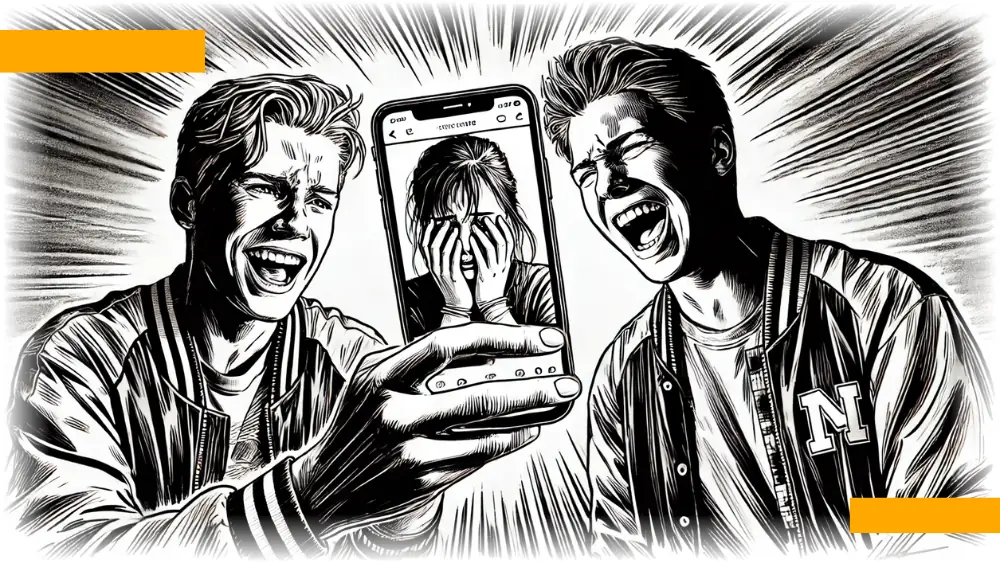 illustration: DALL-E
illustration: DALL-EThe report It’s just a joke: gender, sexuality and trivialisation in adolescent online violence such as cyberhate, cyberbullying, and online grooming by María Reneses, María Riberas-Gutiérrez, and Nereida Bueno-Guerra is the result of the European RAYUELA project. The study aimed to understand how gender and sexual orientation influence both experiencing and committing violence online. The findings are clear. The digital world, although seemingly democratic, is not free from inequality and stereotypes.
The authors conducted a two-step study. First, eight focus groups with 47 teenagers in five countries. Then representative surveys among youth in Madrid and Estonia. Both stages revealed a similar picture. Girls and non-heteronormative individuals are more often victims. Boys are more often perpetrators. These differences come from entrenched gender and social roles that the internet not only fails to break but often reinforces.
Boys attack girls suffer
The authors showed that gender largely determines who experiences and who inflicts online violence. Girls more often reported being targets of offensive comments, hate, and verbal harassment, especially about physical appearance. They were also more exposed to social exclusion and receiving unwanted sexual content.
Boys, on the other hand, dominated the group of perpetrators. They admitted more often than girls to sharing offensive memes, taking over accounts, or sending hurtful messages. In focus groups, it was often stated that boys’ aggression is masked as a “joke” and not taken seriously by peers or the perpetrators themselves.
| Role in violence | Boys more often | Girls more often |
|---|---|---|
| Perpetrators | v | |
| Victims | v | |
| Witnesses | v |
Although youth claim “anyone can be a victim” the narratives show clear links between violence and gender. Boys admit less often to being victims. Girls more often explain the violence as caused by their “lack of self-confidence.” This belief reinforces inequality and shifts the blame to those affected.
Most common forms of online violence
- Offensive messages on social media
- Exclusion from peer groups
- Receiving unwanted sexual images
- Sharing private photos or memes without consent
- Contact with adults with sexual undertones
The study also covered violence against LGBTQ+ individuals and people of different ethnic backgrounds. Respondents pointed to racism, homophobia, and sexism as common motives for attacks. Girls and non-heteronormative individuals repeatedly mentioned how hard it is to find understanding or support because hate against them is often justified by their lifestyle or appearance.
Ambiguous jokes and blaming victims
Trivializing violence through humor is one of the most dangerous phenomena described in the report. In focus groups, youth emphasized that many aggressive behaviors are justified as “jokes” or a way of communicating with peers. Boys in particular talked about “joking around” that might look like hate from the outside but is “normal” within the group.
At the same time, victims are often blamed for the violence. The narrative “if someone doesn’t care they won’t be attacked” was repeated often. This thinking reinforces stereotypes and the belief that weakness or sensitivity is the victim’s fault. Girls felt this especially strongly in situations related to appearance and clothing.
| Phenomenon | Girls | Boys |
|---|---|---|
| Receiving unwanted images | 17.2% | 6.4% |
| Peer group exclusion | 13.9% | 9.5% |
| Reporting cyberhate to adults | 21.6% | 11.3% |
| Witnessing violence | 41.2% | 27.8% |
| Admitting to cyberhate | 2.3% | 10.7% |
The data shows clear differences in both experiencing and committing violence. Particularly striking is the role of boys in cases of cyberhate driven by racism and homophobia. In Estonia, 27% of boys admitted insulting others because of their sexual orientation. Among girls, the figure was only 1.9%.
Who adds strangers who blocks
Conversations revealed clear differences in safety strategies. Girls are more cautious on social media. They add only friends or people recommended by others. They block strangers more often when they receive intrusive messages. Boys, on the other hand, showed more curiosity. They more often check the profile of a new contact before deciding to interact.
This behavior might explain why boys have more contact with adults pretending to be peers. But it is girls who more often face attempts by adults to establish relationships. One case told of a man who repeatedly created new accounts to contact a teenage girl despite her blocking him.
Normalization of grooming behaviors
Participants’ stories reveal how so-called grooming contacts have become normalized. Girls mentioned messages from adult men who suggested meetings or sent sexual photos. Some said these behaviors are everyday occurrences and “you just have to learn to ignore them.” Despite being aware of the danger, many downplayed these cases.
Boys were less likely to admit being victims. But in three groups, it was pointed out that they more often play the role of perpetrators. This topic often caused discomfort and the statements were unclear. It can be assumed that there is strong social pressure discouraging boys from talking about such experiences.
Community hate circles and group sexism
In one Spanish focus group, the phenomenon of the “circle of homophobia” was described. Groups of boys fuel hate speech among themselves to build a sense of belonging and dominance. In private settings, they call each other slurs. Then they bring these practices to others at school or online. This group violence mechanism can be especially strong among young boys.
Although sexism online was rarely mentioned spontaneously, after researchers’ questions, youth admitted that women are often mocked in “funny” videos and comments. Girls not only experience such attacks more often but also face criticism from other women. Harsh judgments about “style” or “provocative photos” often come from peers.
**
The study was conducted under the RAYUELA project (EU, Horizon 2020) using a mixed method. Eight focus groups in five countries and a survey of 1,097 teenagers in Madrid and Estonia. Authors María Reneses, María Riberas-Gutiérrez, and Nereida Bueno-Guerra are researchers at Universidad Pontificia Comillas and Cardenal Cisneros University Centre. The findings were published in Humanities and Social Sciences Communications from the Nature group: https://doi.org/10.1057/s41599-025-04928-3
COMMERCIAL BREAK
New articles in section Media industry
Advertising market 2025. Poland, Europe and the World
Marcin Grządka
The global advertising market is growing by 8.8% in 2025 and will reach a value of 1.14 trillion dollars. The industry result in Europe records slightly lower dynamics, at the level of 5.8%. In this comparison, Poland performs clearly above the average. We will record an increase of 8.9% this year and a value of 18.56 billion PLN - estimates WPP Media in the annual report "This Year Next Year".
The print media market 2025. Three global trends
Krzysztof Fiedorek
The market value is 359.53 billion dollars, yet the erosion is visible to the naked eye. The decline for newspapers will amount to -2.3 percent. Despite this, print retains strength: it generates 76 percent of subscription revenues and enjoys 82 percent consumer trust. The future of the industry is defined by hybrid strategies and niche specialization.
Journalism in the age of AI. Why people prefer humans over machines
Krzysztof Fiedorek
Only 12% of people accept news created solely by AI, while 62% prefer those written by humans. At the same time, only 19% notice labels indicating the use of artificial intelligence, while younger audiences ask AI to explain the content to them. These are the findings of the Reuters Institute report on artificial intelligence in media.
See articles on a similar topic:
Books, e-books and audiobooks about the media and for journalists [LINK]
AUTOPROMOCJA Reporterzy.info
Thanks to cooperation with the Amazon, we may suggest you wide offer of great reading opportunity. Studies on the history and media market, interviews, reports and photo guides. Ordering and delivering a book now only takes a few moments. We invite you for a good lecture!
Reading Industry Magazines in Poland 2024: PBC Report
Sylwia Markowska
76% of readers of industry magazines are responsible for purchasing decisions in their workplace. To deepen the understanding of the role of industry press and how it is read, PBC surveyed 2051 respondents from 5 different sectors, gaining the latest insights into the reading habits of this segment of the press in Poland.
Digital media addiction. Why the brain can’t cope
KFi
Digital media can hijack the brain's reward system in ways similar to drugs and alcohol, warned psychiatrist and author Anna Lembke. She emphasized that compulsive use of digital platforms can become a serious addiction. Not just a bad habit or risky behavior.
How to silence fake news? Young Latinos support internet censorship
Krzysztof Fiedorek
In Brazil, a court shut down platform X, cutting off 40 million users. In Colombia, 70% of citizens want information control, and in Chile, 75% of young people support censoring fake news. Is information security replacing freedom of speech as a new trend? [STUDY]





























